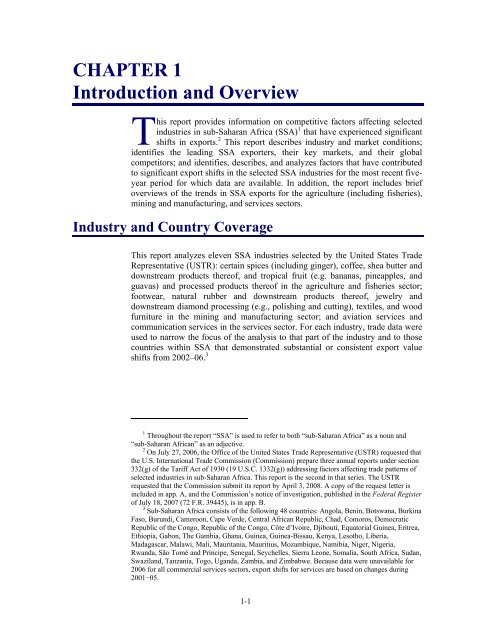Factors Affecting Trade Patterns of - United States International ...
Factors Affecting Trade Patterns of - United States International ...
Factors Affecting Trade Patterns of - United States International ...
Create successful ePaper yourself
Turn your PDF publications into a flip-book with our unique Google optimized e-Paper software.
CHAPTER 1<br />
Introduction and Overview<br />
his report provides information on competitive factors affecting selected<br />
industries in sub-Saharan Africa (SSA) 1 that have experienced significant<br />
shifts in exports. 2 T<br />
This report describes industry and market conditions;<br />
identifies the leading SSA exporters, their key markets, and their global<br />
competitors; and identifies, describes, and analyzes factors that have contributed<br />
to significant export shifts in the selected SSA industries for the most recent fiveyear<br />
period for which data are available. In addition, the report includes brief<br />
overviews <strong>of</strong> the trends in SSA exports for the agriculture (including fisheries),<br />
mining and manufacturing, and services sectors.<br />
Industry and Country Coverage<br />
This report analyzes eleven SSA industries selected by the <strong>United</strong> <strong>States</strong> <strong>Trade</strong><br />
Representative (USTR): certain spices (including ginger), c<strong>of</strong>fee, shea butter and<br />
downstream products there<strong>of</strong>, and tropical fruit (e.g. bananas, pineapples, and<br />
guavas) and processed products there<strong>of</strong> in the agriculture and fisheries sector;<br />
footwear, natural rubber and downstream products there<strong>of</strong>, jewelry and<br />
downstream diamond processing (e.g., polishing and cutting), textiles, and wood<br />
furniture in the mining and manufacturing sector; and aviation services and<br />
communication services in the services sector. For each industry, trade data were<br />
used to narrow the focus <strong>of</strong> the analysis to that part <strong>of</strong> the industry and to those<br />
countries within SSA that demonstrated substantial or consistent export value<br />
shifts from 2002–06. 3<br />
1<br />
Throughout the report “SSA” is used to refer to both “sub-Saharan Africa” as a noun and<br />
“sub-Saharan African” as an adjective.<br />
2<br />
On July 27, 2006, the Office <strong>of</strong> the <strong>United</strong> <strong>States</strong> <strong>Trade</strong> Representative (USTR) requested that<br />
the U.S. <strong>International</strong> <strong>Trade</strong> Commission (Commission) prepare three annual reports under section<br />
332(g) <strong>of</strong> the Tariff Act <strong>of</strong> 1930 (19 U.S.C. 1332(g)) addressing factors affecting trade patterns <strong>of</strong><br />
selected industries in sub-Saharan Africa. This report is the second in that series. The USTR<br />
requested that the Commission submit its report by April 3, 2008. A copy <strong>of</strong> the request letter is<br />
included in app. A, and the Commission’s notice <strong>of</strong> investigation, published in the Federal Register<br />
<strong>of</strong> July 18, 2007 (72 F.R. 39445), is in app. B.<br />
3<br />
Sub-Saharan Africa consists <strong>of</strong> the following 48 countries: Angola, Benin, Botswana, Burkina<br />
Faso, Burundi, Cameroon, Cape Verde, Central African Republic, Chad, Comoros, Democratic<br />
Republic <strong>of</strong> the Congo, Republic <strong>of</strong> the Congo, Côte d’Ivoire, Djibouti, Equatorial Guinea, Eritrea,<br />
Ethiopia, Gabon, The Gambia, Ghana, Guinea, Guinea-Bissau, Kenya, Lesotho, Liberia,<br />
Madagascar, Malawi, Mali, Mauritania, Mauritius, Mozambique, Namibia, Niger, Nigeria,<br />
Rwanda, São Tomé and Príncipe, Senegal, Seychelles, Sierra Leone, Somalia, South Africa, Sudan,<br />
Swaziland, Tanzania, Togo, Uganda, Zambia, and Zimbabwe. Because data were unavailable for<br />
2006 for all commercial services sectors, export shifts for services are based on changes during<br />
2001−05.<br />
1-1

















